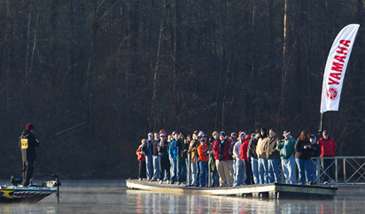
The conclusion of the Sooner Run event at Oklahoma’s Fort Gibson Lake in June was the beginning of Mike Iaconelli’s marathon preparation for the 2011 Bassmaster Classic. “The last fish that I weighed and knew that I was in the Classic, that is the minute I started thinking about the Classic,” recalls Iaconelli.
For the past six and a half months, Iaconelli has followed a two-part process he uses for Elite Series events to prepare for the Classic. “In theory it’s the same [as preparing for an Elite Series event]; it’s just a lot larger on the amount of time I put in,” he says.
The New Jersey pro started preparing for the Classic at home by researching the Louisiana Delta through back issues of magazines, websites of fish and game agencies and local contacts.
Rather than collecting waypoints from local anglers, Iaconelli keyed on generalities of the fishery and “buzz words” from about two dozen sources. When key words about lure colors, water clarity, vegetation or sections of the Delta kept popping up, Iaconelli would jot down these buzz words in his notes.
His next research step involved plugging a formula he calls General Universal Seasonal Patterns into the maps. “It’s kind of a template that tells me where the bass are going to live based on the seasonal pattern,” he says. “Wherever you are, a bass is a bass, and it goes through certain things during its life cycle of the four seasons.
So based on that template, I know that when we get to the Louisiana Delta in the third week of February, I can tell you that the fish are going to be in the wintering mode or the prespawn mode depending on current weather conditions.” The research and GUSP template helps Iaconelli eliminate water before he gets to the Delta. “It takes a place that is 500,000 fishable acres and lets me reduce it to 20,000 acres,” says Iaconelli. Throughout July and August, Iaconelli spent most of his research time for the Classic building a map base on the Delta. His sources included the Army Corps of Engineers, National Oceanic & Atmospheric Administration, Navionics downloads and post-Katrina aerial maps.
The second part of his Classic preparations involved a prefishing trip, which he never does for Elite Series tournaments. “Every year for the Classic I make a trip before it cuts off,” says Iaconelli, who prefished the Delta for 10 days. “Based on the information and the areas I have kind of predicted by looking at the maps, I went out with my boat and made those areas even smaller by doing on-the-water scouting.”
During his prefishing trip, Iaconelli estimated he spent 70 percent of his time looking at the water and only about 30 percent actually fishing. He looked for areas of changes from deep to shallow water, grass to open water, grass to wood, etc. When he found an area he liked, Iaconelli dropped a marker buoy and started fishing it with a crankbait, big jig or a Carolina rig with a tungsten weight. “I still was not trying to catch a fish, but I was using the baits as transmitters of what was down there,” says Iaconelli. Bumping these lures along the bottom and into objects helped him find the sweet spots of an area. After marking the sweet spot as a waypoint, Iaconelli jotted down the waypoint number on his map and noted some information on the cover and structure of the spot, along with the water temperature and clarity and what the tide was at the time he visited the spot.
Tackle and boat preparations are next on Iaconelli’s agenda for his 12th Classic. “The next month for me shifts to making sure I have all the baits, weights, hooks, rods, reels and line I need,” he says. Since he and his wife, Becky, are expecting a baby on Feb. 3, Iaconelli plans on having someone drive his rig down to Louisiana, which will allow him to fly to New Orleans on Feb. 10, the day before official Classic practice begins.
Editor’s Note: If you have a story idea you would like to vote on for an upcoming poll, send your idea to john@jnoutdoors.com.





